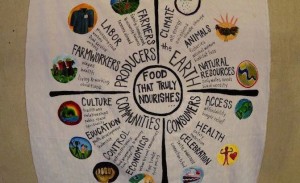I became interested in food justice when I read the book The Ethics of What We Eat by Peter Singer when I first started college. After learning about the mistreatment of animals and workers in the corporate food system as well as the environmental effects of factory farming, I could no longer justify eating meat.
From that point, I continued reading about the problems in the food system and came to realize how various elements seemed intertwined with the things I was studying in my classes. When I became serious about studying Spanish, for example, I began to read about how many immigrant laborers are treated and discovered that oftentimes workers who pick the shiny fruit in our grocery stores work in slave-like conditions.
Thus, I’ve always been skeptical about how sustainable the food served in our cafeteria is because feeding such a large group of students each day is such a massive corporate endeavor. Additionally, once I had my own kitchen, I grew skeptical and confused about the food that I was buying for myself. Is it really better to buy local? Why are fair trade foods so expensive? What does free range REALLY mean?
Last night, a speaker on campus presented the most succinct and full interpretation of the elements of food justice that I have come across, and told us about how the model can be used in large dining endeavors such as those on college campuses.
The image is part of the Real Food Challenge, a national movement to unite food activists of different types under the common goal of improving food quality. From those who are concerned about losing culture through dwindling crop diversity to environmentalists who are concerned with emissions of factory farms, the Real Food web is a catch-all that serves as a uniting model.

http://www.realfoodchallenge.org/sites/realfoodchallenge.drupalgardens.com/files/katie%20cloth%20wheel.jpg
In college campuses across the country, students have been tracking the food in their dining halls to determine how much, according the parameters set by the Real Food Challenge, is “real.” The answer, because most schools contract large corporations to supply food, is not much. The food we are served in the cafeteria is rarely grown sustainably, and farmers around the world are not paid fair wages for the food that ends up on our plates.
The goal, once a school pledges to join the challenge, is that by the year 2020, 20% of the food served in the cafeteria will be real. Here at McDaniel, we are at the beginning of the process to achieve this goal for better food! Stay tuned for information on our next step.

Leave a Reply